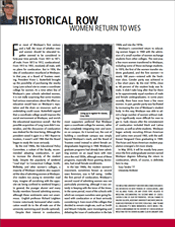HISTORICAL ROW: WOMEN RETURN TO WES
 For most of Wesleyan’s first century and a half, the issue of whether men and women should be educated together seemed to be considered in forty–year time periods. From 1831 to 1871, all male. From 1872 to 1912, coeducational. From 1913 to 1955, resolutely all male, with no plans for coeducation. But in 1956, the idea of coeducation resurfaced at Wesleyan. In that year, at a Board of Trustees meeting, President Victor L. Butterfield brought up the possibility of purchasing the nearby Long Lane school site to create a coordinate college for women. At a time when few of Wesleyan’s peer schools admitted women, it is not really surprising that some trustees had serious reservations about the effect coeducation would have on Wesleyan’s reputation and the drain on resources such an undertaking could cause. Butterfield argued that a coordinate college would improve the social environment at Wesleyan, and enrich the educational experience overall. But the possible acquisition of Long Lane didn’t materialize, and the discussion of coeducation was shelved for the time being. Although the president raised it again in a 1961 Report to trustees, it wasn’t until 1966 that the Board began to study the issue seriously.
For most of Wesleyan’s first century and a half, the issue of whether men and women should be educated together seemed to be considered in forty–year time periods. From 1831 to 1871, all male. From 1872 to 1912, coeducational. From 1913 to 1955, resolutely all male, with no plans for coeducation. But in 1956, the idea of coeducation resurfaced at Wesleyan. In that year, at a Board of Trustees meeting, President Victor L. Butterfield brought up the possibility of purchasing the nearby Long Lane school site to create a coordinate college for women. At a time when few of Wesleyan’s peer schools admitted women, it is not really surprising that some trustees had serious reservations about the effect coeducation would have on Wesleyan’s reputation and the drain on resources such an undertaking could cause. Butterfield argued that a coordinate college would improve the social environment at Wesleyan, and enrich the educational experience overall. But the possible acquisition of Long Lane didn’t materialize, and the discussion of coeducation was shelved for the time being. Although the president raised it again in a 1961 Report to trustees, it wasn’t until 1966 that the Board began to study the issue seriously.
By the mid 1960s, the Educational Policy Committee, a subset of the faculty, recommended adopting coeducation, in part to increase the diversity of the student body. Despite the popularity of weekend “road trips” to Connecticut College, Smith, Wellesley, and other women’s colleges, a majority of Wesleyan students also supported the idea of admitting women at Wesleyan. (For readers too young to remember road trips, imagine all socializing with the opposite sex being confined to weekend binges.) In general, the younger alumni and many faculty members favored admitting women, although these sentiments were not unanimous. English professor Richard Leighton Greene notoriously bemoaned what coeducation would do to the all–male use of the university swimming pool (trunks optional).
Despite their interest in coeducation, most supporters preferred that Wesleyan open a coordinate college for women, rather than completely integrating men and women on campus. As it turned out, the cost of building a coordinate campus was simply beyond Wesleyan’s reach, and the Board of Trustees voted instead to admit female undergraduates beginning in 1968. Wesleyan’s graduate programs had already been admitting women on an equal basis with men since the mid 1950s, although most of these programs, especially those granting doctorates, had small female enrollments.
In the late 1960s, the modern women’s movement, sometimes known as second wave feminism, was in full swing. Unlike the first period of coeducation, Wesleyan’s second round of admitting women was not particularly pioneering, although it was certainly in keeping with the tenor of the times. In the same period, most of the schools with which we compare ourselves were going forward with coeducation or at least seriously considering it. Even most of the colleges that decided to remain single–sex, such as Smith and Mount Holyoke, were investigating and debating the issue of coeducation in the late 1960s and into the 1970s.
Wesleyan’s committed return to educating women began in 1968 with the admission of a small number of women exchange students from other colleges. The next year, a few more women transferred to Wesleyan, including some of those exchange students. In 1970, the first of the women transfer students graduated, and the first women—in nearly 100 years—entered with the freshman class. Gender parity was achieved in a few short years. By the mid 1970s, close to 40 percent of the student body was female. It didn’t take long after that for there to be approximately equal numbers of male and female undergraduates; in some years recently, there have even been a few more women. In part, gender parity was facilitated by increasing the size of Wesleyan’s student body. In this way, Wesleyan was able to admit a large number of women without making it significantly more difficult for men to get in. Early classes after the reinstatement of coeducation included black and Latina women, as well as white students. Wesleyan began actively recruiting African American and Latino men around 1965, with the well–known Vanguard Class graduating in 1969. The Asian and Asian–American student population emerged a bit more slowly.
In May 2010, it will be exactly forty years since the first undergraduate women earned Wesleyan degrees following the return to coeducation, which, of course, is definitely here to stay.
—Suzy Taraba ’77
University Archivist

